It seems like no time ago at all that I was
singing the praises of the magnificent
Fallout 3 to the rafters and looking forwards to playing its seemingly vast expanse of
extra add-on content. But I've played my way through the lot now, and am facing down the barrel of a
Fallout-less future ... well, at least until the fortuitous autumn release of
Fallout: New Vegas!
Anyway, so what were these mini-adventures in the
Capital Wasteland like? Well, in the order that I played them ...
Broken Steel
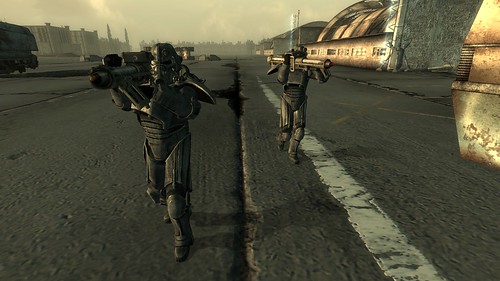
Although not the first released,
Broken Steel is an obvious first port-of-call since it affords the player character a less self-sacrificing climax to
Fallout 3 and the chance to continue their adventures in the Wasteland. Perhaps more importantly, it ups the cap placed on the experience level of the player character, allowing them to acquire even more refined huntin', shootin' and, well, nukin' skills. Also, unlike the other expansions, it is a straight continuation of the main
Fallout 3 storyline, and deals largely with the continued pursuit of the dastardly Enclave by the saintly Brotherhood, partly through the Wasteland, but also in new areas just outside of it (most significantly
Andrews Air Force Base).
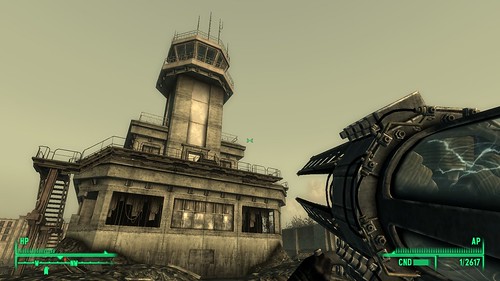
This is a pretty fun add-on. Playing it, as I did, straight after the main
Fallout 3 storyline, made it a fairly seamless experience that slotted nicely into the events that took place then. It makes good use of a couple of peripheral locations in the Wasteland, and tacks on a nice, if somewhat sparsely populated, rendition of Andrew AFB for the finale. Which includes, needless to say, a bit of spectacular nuking (or back-stabbing betrayal if I'd chosen the Dark Side). However, picking up on the success of Project Purity, it also involves a few enjoyable side missions that take in the economics and politics of the sudden availability of fresh and safe water in the Wasteland. I almost enjoyed these more than the more straightforwardly militaristic main storyline.
Operation: Anchorage

Eschewing the subtlety and role-playing elements of the main
Fallout 3 storyline,
Operation: Anchorage heads off in a more traditional first-person shooter direction. It begins (and, in a sense, remains) at an Outcast bunker in the Wasteland, where the player is inducted into a virtual reality simulation of the Alaskan conflict that led up to the Great War of 2077. Solo or as part of a hand-picked squad, the player must negotiate a series of frosty hurdles to liberate Anchorage from the Red Chinese. Defeating the simulated Reds will unlock a strong room back in the Wasteland bunker, making available some valuable technology to both the Outcasts and to the player. The missions in the Alaskan simulation involve disabling the heavy guns that are shelling Anchorage, destroying a series of strategic targets in the town, and facing down the Chinese commander one-on-one.
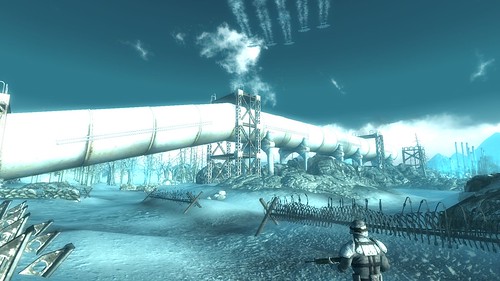
I have to say that this add-on was something of a disappointment. After the complexity of
Fallout 3, this really is just harking back to more conventional "shooters" of bygone days. Interactions with NPCs are bare-bones affairs at best, and the purported squad-based combat seemed to serve only as another impediment to clear. I struggled to put a squad together, but once I saw their battlefield performance, I made sure to ditch them the first chance that I got. In its defense, this add-on is set in an extremely attractive polar setting, especially in the early sections that take place in the mountains that surround Anchorage (though it doesn't take much to be more attractive than the Wasteland!). But this scene-setting prettiness is let down by the linear plotting and utterly conventional combat.
The Pitt

Alluded to several times in
Fallout 3, the backstory of the Brotherhood of Steel includes an episode on their journey from California to Washington DC in
The Pitt, formerly
Pittsburgh. Here, they found, then wiped out, a large Raider encampment, but left behind one of their number, Ashur, for dead. 30 years later, Ashur has resurrected The Pitt's industry and runs a massive foundry there. However, he has done so on the backs of slaves, and the player is drawn to The Pitt by an escaped slave, Wernher, who is ostensibly looking to free all those indentured there. Posing as a returning runaway slave, the player must infiltrate the foundry, then work up the ranks to reach a position where a slave rebellion can be instigated. This career progression is hampered by the conditions in the foundry, and by its infestation with Raiders and sub-human "trogs", victims of The Pitt's extreme radiation. However, the prize of freedom for the slaves, and the hint of a cure for the radiation sickness, are strong motivating factors. Or are they? Things are not are as morally black-and-white as they first appear in
The Pitt.

A much better expansion this time around.
The Pitt is far more in keeping with the balance between role-playing and combat that was established in
Fallout 3. Along with the new, industrial setting, there are a large number of characters to meet, help or betray. What's more is that they're worked into a nice plot in which "doing the right thing" is not as straightforward as it first seems. Having single-handedly wiped out
Paradise Falls in the original game, I blazed into The Pitt thinking I'd found a whole new set of slaves to liberate, only to belatedly uncover circumstances that were a lot less clear-cut. If I could be a little critical,
The Pitt is somewhat on the small size, consisting more or less solely of a central quest with no substantial side quests. Also, though it again introduces a whole new map, exploration is not a big part of it, and it doesn't take very long to get the measure of the foundry and its surrounds. But leaving these quibbles aside, it's a more fully realised expansion than the previous two, and one that's both truer to
Fallout 3 and a lot of fun to boot.
Mothership Zeta
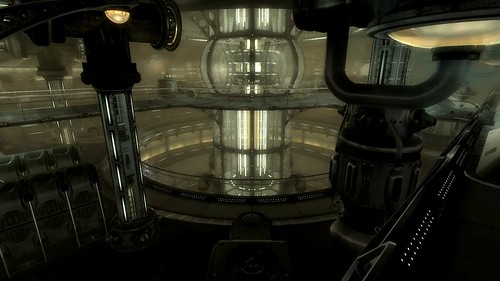
Drawing from the rich repertoire of B-movie science fiction,
Mothership Zeta takes the player out of the Wasteland, in fact right off of the Earth. After being drawn by a mysterious beacon to the crash site of a downed
UFO, the player is teleported aboard the eponymous spaceship. While some scientists have speculated that only peaceful and friendly civilizations are likely to survive long enough to develop
interstellar travel, the aliens of
Fallout 3 obviously haven't read this research, and favour electrocution and disintegration over pan-galactic harmony. Thrown in with a number of fellow abductees, some of whom have been in cryofreeze for centuries, the player must escape from their alien captors, then work slowly through various levels to ultimately hijack
Mothership Zeta.

Upfront, I was convinced this would be a great add-on.
[*] The retro-futurism of
Fallout 3 should have gelled perfectly with the raygun aesthetic of 1950s science fiction that the aliens are drawn from. Certainly, a lot of effort has clearly been ploughed into the visual (and accoustic) appearance of the add-on, what with its classically
Grey-like aliens, tail-finned
rayguns and a beautifully-realised spaceship. But all this promise is lost in an add-on that, while admittedly sizeable, boils down to little more than conventional shootin'-and-key-findin'. In this regard,
Mothership Zeta has a lot in common with
Operation: Anchorage, being both rather beautiful but also rather shallow. There is a bit more NPC interaction in this add-on, but it serves as little more than a route for plot exposition, since there's nothing sophisticated or clever about what the player has to achieve (namely: seize control of mothership; escape from mothership). In fact, since
Operation: Anchorage is shorter, its lack of complexity is less tiresome than that of
Mothership Zeta. I was more than a little pleased to finally take charge of the mothership, but only so I could get straight back down to the Wasteland.
Point Lookout
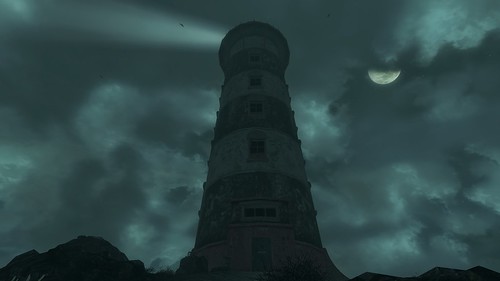
Last, but about as far from least as is possible to be, comes
Point Lookout, set in the swamplands of the
eponymous State Park to the south of Washington DC. The player is directed there from the Wasteland by Catherine, a mother fretting about her runaway daughter, Nadine, who has headed there to find her fortune. One
paddle steamer voyage later, and the player disembarks in a landscape that, while spared from the bombs, is still dangerously radioactive. Once Point Lookout was a tourist destination, with a seafront carnival, a big wheel, and a rich heritage. Now, alongside its handful of ragtag survivors, it plays host to smugglers, moonshiners, a religious cult and rancorous, mutant hill-billies. Furthermore, the swamps are also full of much older dangers and secrets, some from the Great War, some dating centuries further back to the Civil War. As gradually becomes apparent, some of these secrets need investigating, while some need laying -permanently- to rest.

By complete chance I saved the best of
Fallout 3's expansion packs for last.
Point Lookout stands head and shoulders above the other add-ons, and deftly balances a diverse range of "missions" with a large map ripe for exploration, all wreathed in a rich,
Southern Gothic atmosphere. It was very pleasing to be freed up to explore again, and to gradually uncover all of the swampland's secrets for myself, rather than just following some A → B → C trail rigidly dictated by geography or single-purpose NPCs. Best of all, it was nice to be enveloped in a story (well, a series of interlocking stories) in which that rare commodity,
imagination, had been used. As well as tracking down Nadine, I also found myself following in the footsteps of a long-dead Chinese spy, brewing up moonshine, investigating the murder of a natural gas-prospecting geologist, joining a cult that reveres a hallucinogenic plant, and settling a centuries-long battle of wits between two arch-rivals. All (and more) of which were both carefully plotted and populated by interesting NPCs. I particularly liked the little ancillary missions that had me digging for buried treasure in a flooded delta, and getting Point Lookout's lighthouse back into working order. There's also a fantastic hallucination section in which the player character's fears and disappointments are vividly brought to life. Finally, while it does pander to stereotypes somewhat, it's difficult not to be amused by
Point Lookout's southern references, especially the introduction of
hillbilly mutants. Very
Deliverance.
By way of summary, and in case it's not obvious already, I'd rank
Fallout 3's expansions as follows ...
- Point Lookout
- The Pitt
- Broken Steel
- Operation: Anchorage
- Mothership Zeta
For my money (not that I spent any; this was a birthday present),
Point Lookout clearly deserves top billing among the various expansions. Its gameplay could be criticised as being too similar to
Fallout 3, but that's a bonus in my book, especially when deviating from the
Fallout 3 formula appears to produce such limp results. I'd place
The Pitt next, followed by
Broken Steel, although this is a bit more of a toss-up because the former is a little on the short side, and the latter does raise the level-cap (though still not enough for my liking).
Operation: Anchorage and
Mothership Zeta bring up the rear, but distantly. In spite of looking lovely, both are just too straightforward and linear to hold a candle up to the other add-ons. Given all the fun that's to be had with
Fallout 3, it's rather damning to say that
Mothership Zeta is too lengthy. This drags it firmly into last place, though it's still well worth a look, with the emphasis on
look.
Anyway, that's the end of my journey in post-apocalyptia until at least later this year. Arse. Next up, and courtesy of some good friends, I've got a choice of
vigilante violence or
Grand Theft Jungle.
As for my earlier stay in
Fallout 3, there are a number of screenshots from the expansion packs
over at Flickr.
[*] Leaving aside any issues I have with the quality of
Mothership Zeta, I'd add that it also introduces, well,
existential issues to the world of
Fallout. By explicitly introducing a world beyond the ruined Earth, even one filled with murderous aliens, the devastation wrought during the Great War somehow loses its power. It's important (at least for me) that the survivors in the Wasteland have to make the most of it, and that its only through their efforts that things are going to get better. The presence of an alien civilization advanced enough to travel to the Earth opens the door to shortcut fixes, and to the possibility of just leaving the Earth behind. Which conflicts, in my mind, with the efforts to "build a better world" as the game encourages the player to do. Further, judging from the time period that the aliens have been sampling humans for (hundreds of years), one is left with the suspicion that they may even have precipitated the Great War. Part of the power of
Fallout lies in the knowledge that humanity is responsible for the destruction wrought on the Earth. Anyway, it is obviously only a game (and is the least "serious" of the add-ons), but as well as being something of a duff installment,
Mothership Zeta also serves to cloud the significance of the events playing out in
Fallout's shattered world.







.png)


















